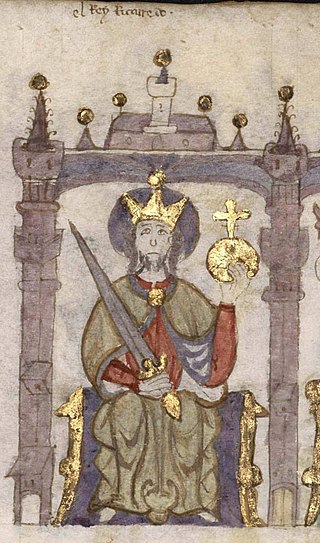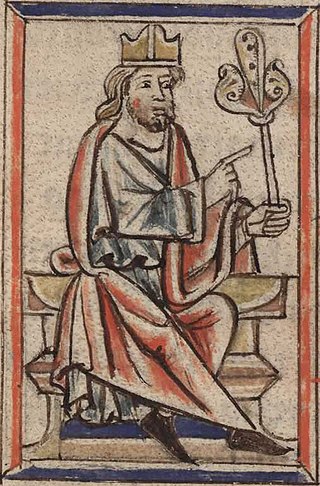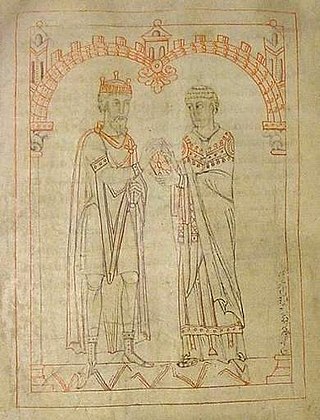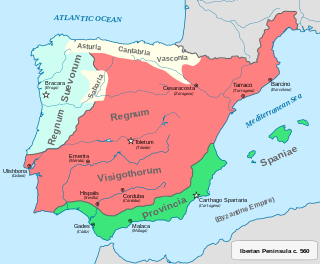
Alaric II was the King of the Visigoths from 484 until 507. He succeeded his father Euric as king of the Visigoths in Toulouse on 28 December 484; he was the great-grandson of the more famous Alaric I, who sacked Rome in 410. He established his capital at Aire-sur-l'Adour in Aquitaine. His dominions included not only the majority of Hispania but also Gallia Aquitania and the greater part of an as-yet undivided Gallia Narbonensis.

Isidore of Seville was a Hispano-Roman scholar, theologian, and archbishop of Seville. He is widely regarded, in the words of 19th-century historian Montalembert, as "the last scholar of the ancient world".

Year 549 (DXLIX) was a common year starting on Friday of the Julian calendar. The denomination 549 for this year has been used since the early medieval period, when the Anno Domini calendar era became the prevalent method in Europe for naming years.
Year 551 (DLI) was a common year starting on Sunday of the Julian calendar. The denomination 551 for this year has been used since the early medieval period, when the Anno Domini calendar era became the prevalent method in Europe for naming years.

Athanagild was Visigothic King of Hispania and Septimania. He had rebelled against his predecessor, Agila I, in 551. The armies of Agila and Athanagild met at Seville, where Agila met a second defeat. Following the death of Agila in 554, he was sole ruler for the rest of his reign.

Reccared I was Visigothic King of Hispania and Septimania. His reign marked a climactic shift in history, with the king's renunciation of Arianism in favour of Roman Christianity in 587.

Gesalic, Gesaleico in Spanish and Portuguese, Gesaleic in Catalan,, was a king of the Visigoths from 507 to 511, and died in 513.

Hermeric was the king of the Suevi from at least 419 and possibly as early as 406 until his abdication in 438.

Liuva I 571–572, or 573) was a Visigothic King of Hispania and Septimania.

Witteric was the Visigoth King of Hispania, Septimania and Galicia. He ruled from 603 to 610.

Gundemar was a Visigothic King of Hispania, Septimania and Galicia (610–612).

Olite is a town and municipality located in the Comarca de Tafalla comarca, Merindad de Olite merindad, in Navarre, Spain.

The Kingdom of the Suebi, also called the Kingdom of Galicia or Suebi Kingdom of Galicia, was a Germanic post-Roman kingdom that was one of the first to separate from the Roman Empire. Based in the former Roman provinces of Gallaecia and northern Lusitania, the de facto kingdom was established by the Suebi about 409, and during the 6th century it became a formally declared kingdom identifying with Gallaecia. It maintained its independence until 585, when it was annexed by the Visigoths, and was turned into the sixth province of the Visigothic Kingdom in Hispania.

Miro was the Suebian King of Galicia from 570 until his death in 583. His reign was marked by attempts to forge alliances with other Chalcedonian Christian nations with the goal of checking the power of the Arian Visigoths under Leovigild. During his reign relations were established with both Francia and the Byzantine Empire and the kingdom reached its zenith, but it collapsed within three years of his death.

Spania was a province of the Eastern Roman Empire from 552 until 624 in the south of the Iberian Peninsula and the Balearic Islands. It was established by the Emperor Justinian I in an effort to restore the western provinces of the Empire.
The Ruccones were a tribal group, probably related to the Astures or the Basques, who lived semi-autonomously in northern Hispania from the fifth through to the seventh centuries. Their population area extended approximately from modern-day Asturias to La Rioja.

Theodoric I was the King of the Visigoths from 418 to 451. Theodoric is famous for his part in stopping Attila the Hun at the Battle of the Catalaunian Plains in 451, where he was killed.

Theudigisel, was king of the Visigoths in Hispania and Septimania (548–549). Some Visigothic king lists skip Theudigisel, as well as Agila I, going directly from Theudis to Athanagild.
The Chronicle of 741 is a Latin-language history in 43 sections or paragraphs, many of which are quite short, which was composed in about the years 741-743 in al-Andalus. It is the earliest known Christian work produced under Muslim rule in Iberia.

Baddo (Bauda) was a Visigoth queen consort by marriage to King Reccared I (580–601). She is the only Visigoth queen consort known to have signed official state documents and church documents, which signifies that she played a role in politics and had some influence over the government.
















